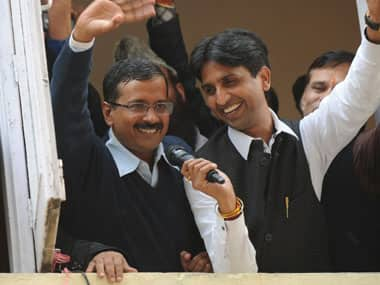One of the reasons why Arvind Kejriwal’s Aam Aadmi Party (AAP) gets so much mileage in the media is the apparently “stunning” near-victory it pulled off barely a year after formal launch. Most commentators went breathless talking about the AAP feat in Delhi, where Kejriwal humbled Sheila Dikshit and wrested 28 seats to become the second largest party in the assembly, “coming out of nowhere”, as The Indian Express put it. David versus Goliath battles always play out well in the media, but the truth is our David was not a mere untested stripling facing a battle-tested incredible hulk. He had his own strengths, while his opponents were weighed down by legacy issues. As Malcolm Gladwell points out in his latest book, David and Goliath, David was not an untested kid. He was an expert user of the sling, “a devastating weapon” in the hands of an expert, Gladwell told Inc magazine in an interview. “It’s one of the most feared weapons in the ancient world. The stone that comes from his sling has the stopping power equivalent to a bullet from a .45 caliber pistol. It’s a serious weapon. And second, there are many medical experts who believe that Goliath was suffering from acromegaly, which causes you to grow. Many giants have acromegaly, but it has a side effect which is, it causes restrictive sight. Goliath in the biblical story does, if you look closely, sound like a guy who can’t see.” Little wonder, slingshot expert David beat a bumbling giant Goliath who could not see or move fast. [caption id=“attachment_1277425” align=“alignleft” width=“380”]  Arvind Kejriwal after his win. AFP.[/caption] This is the real story of the Delhi battle between AAP and Congress. AAP had all the room to manoeuvre, while Congress was caught in its heavy armour, unable to move or see what’s in front. The Congress fares well when it can fight with official machinery and backroom intrigue, but when someone fights a guerilla political war out in the field of public opinion, the big tanks are of no use. Consider why Kejriwal was no novice in this battle. First, he was not really someone who emerged from nowhere to beat Sheila Dikshit. He was the product of the Anna Hazare anti-corruption movement that began nearly three years ago in Delhi, and he rose on the crest of the wave that sank the Congress. When the collective anger of a people manifests itself, leaders get thrown up automatically. Kejriwal was the one. Just as the BJP saw Kejriwal as someone who robbed it of sure victory, Kejriwal can say that but for the BJP, AAP would have come to power last Sunday. Second, as someone with no legacy of corruption to defend, Kejriwal could target anybody and everybody, but nobody could retaliate. He could make allegations – and his opponents could only gnash their teeth in impotent rage because arresting him would have been counter-productive. Never being in government gave him a unique advantage that even the BJP did not have. This is why he will be coy about trying to form a government in Delhi. The ability to oppose gives him greater freedom and power than the actual trappings of the chief ministerial office. Third, Kejriwal’s feat is not unique to India at all. Every party created by an upsurge of strong sentiment or mass movement has risen similarly to beat the stuffing out of established parties. In 1997, the Janata party emerged from nowhere to gain a majority in the Lok Sabha - something no party had ever achieved before. NT Rama Rao’s Telugu Desam took less than nine months to oust the Congress in Andhra Pradesh on the issue of Telugu pride in 1983. The Asom Gana Parishad won the very first election it contested as a political party after leading the anti-foreigner movement under the banner of the All Assam Students Union. In Odisha, the Biju Janata Dal won its very first assembly outing in 2000 and has never let go of power since then. And this is by no means an exhaustive list. Nevertheless, Kejriwal was happy to harp on the David vs Goliath story to feed the media. While delivering his “victory” speech, he pointed out how relative non-entities managed to dethrone political stalwarts. He talked about “ choti si ladki” Rakhi Birla (“ek samanya si patrakaar thi”), who beat Raj Kumar Chauhan of the Congress, and Akhileshpati Tripathi, someone who had come to Delhi to write the civil services exam, who beat Ashok Goel of the BJP, as examples of ordinary folks beating the giants. But consider what the DMK did as far back as 1967. A product of the Dravidian movement of the last century and the anti-Hindi agitation of 1965, the DMK simply swept the Congress aside in one fell swoop. Just like Kejriwal’s “choti si ladki” beat Raj Kumar Chauhan, a mere student leader, P Seenivasan, felled the tallest Tamil Congress leader of that time, K Kamaraj. Kamaraj, who had had an accident just before the election and could not campaign, famously boasted that he could win lying down (“Padutthukonde jeippom”). Not only he, but even Tamil Nadu Chief Minister M Bhakthavatsalam was defeated. None of this takes anything away from Kejriwal’s performance, but we should see his feat in perspective: it’s been done before. In India, many Davids have beaten many Goliaths.
Is Kejriwal the first Indian David to beat Goliath? Not quite. In India, parties and leaders have often come from nowhere to take the crown
Advertisement
End of Article
Written by R Jagannathan
R Jagannathan is the Editor-in-Chief of Firstpost. see more


)
)
)
)
)
)
)
)
)



